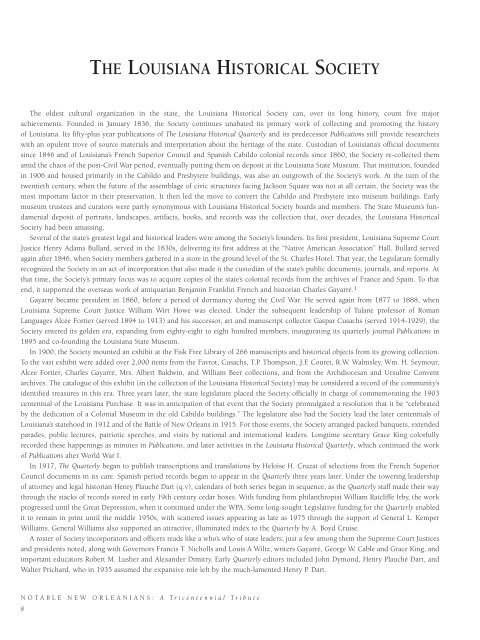Notable New Orleanians: A Tricentennial Tribute
An illustrated history of New Orleans paired with the histories of companies that have helped shape the city.
An illustrated history of New Orleans paired with the histories of companies that have helped shape the city.
Create successful ePaper yourself
Turn your PDF publications into a flip-book with our unique Google optimized e-Paper software.
THE LOUISIANA HISTORICAL SOCIETY<br />
The oldest cultural organization in the state, the Louisiana Historical Society can, over its long history, count five major<br />
achievements. Founded in January 1836, the Society continues unabated its primary work of collecting and promoting the history<br />
of Louisiana. Its fifty-plus year publications of The Louisiana Historical Quarterly and its predecessor Publications still provide researchers<br />
with an opulent trove of source materials and interpretation about the heritage of the state. Custodian of Louisiana’s official documents<br />
since 1846 and of Louisiana’s French Superior Council and Spanish Cabildo colonial records since 1860, the Society re-collected them<br />
amid the chaos of the post-Civil War period, eventually putting them on deposit at the Louisiana State Museum. That institution, founded<br />
in 1906 and housed primarily in the Cabildo and Presbytere buildings, was also an outgrowth of the Society’s work. At the turn of the<br />
twentieth century, when the future of the assemblage of civic structures facing Jackson Square was not at all certain, the Society was the<br />
most important factor in their preservation. It then led the move to convert the Cabildo and Presbytere into museum buildings. Early<br />
museum trustees and curators were partly synonymous with Louisiana Historical Society boards and members. The State Museum’s fundamental<br />
deposit of portraits, landscapes, artifacts, books, and records was the collection that, over decades, the Louisiana Historical<br />
Society had been amassing.<br />
Several of the state’s greatest legal and historical leaders were among the Society’s founders. Its first president, Louisiana Supreme Court<br />
Justice Henry Adams Bullard, served in the 1830s, delivering its first address at the “Native American Association” Hall. Bullard served<br />
again after 1846, when Society members gathered in a store in the ground level of the St. Charles Hotel. That year, the Legislature formally<br />
recognized the Society in an act of incorporation that also made it the custodian of the state’s public documents, journals, and reports. At<br />
that time, the Society’s primary focus was to acquire copies of the state’s colonial records from the archives of France and Spain. To that<br />
end, it supported the overseas work of antiquarian Benjamin Franklin French and historian Charles Gayarré. 1<br />
Gayarré became president in 1860, before a period of dormancy during the Civil War. He served again from 1877 to 1888, when<br />
Louisiana Supreme Court Justice William Wirt Howe was elected. Under the subsequent leadership of Tulane professor of Roman<br />
Languages Alcée Fortier (served 1894 to 1913) and his successor, art and manuscript collector Gaspar Cusachs (served 1914-1929), the<br />
Society entered its golden era, expanding from eighty-eight to eight hundred members, inaugurating its quarterly journal Publications in<br />
1895 and co-founding the Louisiana State Museum.<br />
In 1900, the Society mounted an exhibit at the Fisk Free Library of 266 manuscripts and historical objects from its growing collection.<br />
To the vast exhibit were added over 2,000 items from the Favrot, Cusachs, T.P. Thompson, J.F. Couret, R.W. Walmsley, Wm. H. Seymour,<br />
Alcee Fortier, Charles Gayarré, Mrs. Albert Baldwin, and William Beer collections, and from the Archdiocesan and Ursuline Convent<br />
archives. The catalogue of this exhibit (in the collection of the Louisiana Historical Society) may be considered a record of the community’s<br />
identified treasures in this era. Three years later, the state legislature placed the Society officially in charge of commemorating the 1903<br />
centennial of the Louisiana Purchase. It was in anticipation of that event that the Society promulgated a resolution that it be “celebrated<br />
by the dedication of a Colonial Museum in the old Cabildo buildings.” The legislature also had the Society lead the later centennials of<br />
Louisiana’s statehood in 1912 and of the Battle of <strong>New</strong> Orleans in 1915. For those events, the Society arranged packed banquets, extended<br />
parades, public lectures, patriotic speeches, and visits by national and international leaders. Longtime secretary Grace King colorfully<br />
recorded these happenings as minutes in Publications, and later activities in the Louisiana Historical Quarterly, which continued the work<br />
of Publications after World War I.<br />
In 1917, The Quarterly began to publish transcriptions and translations by Heloise H. Cruzat of selections from the French Superior<br />
Council documents in its care. Spanish period records began to appear in the Quarterly three years later. Under the towering leadership<br />
of attorney and legal historian Henry Plauché Dart (q.v), calendars of both series began in sequence, as the Quarterly staff made their way<br />
through the stacks of records stored in early 19th century cedar boxes. With funding from philanthropist William Ratcliffe Irby, the work<br />
progressed until the Great Depression, when it continued under the WPA. Some long-sought Legislative funding for the Quarterly enabled<br />
it to remain in print until the middle 1950s, with scattered issues appearing as late as 1975 through the support of General L. Kemper<br />
Williams. General Williams also supported an attractive, illuminated index to the Quarterly by A. Boyd Cruise.<br />
A roster of Society incorporators and officers reads like a who’s who of state leaders; just a few among them the Supreme Court Justices<br />
and presidents noted, along with Governors Francis T. Nicholls and Louis A Wiltz, writers Gayarré, George W. Cable and Grace King, and<br />
important educators Robert M. Lusher and Alexander Dimitry. Early Quarterly editors included John Dymond, Henry Plauché Dart, and<br />
Walter Prichard, who in 1935 assumed the expansive role left by the much-lamented Henry P. Dart.<br />
NOTABLE NEW ORLEANIANS: A <strong>Tricentennial</strong> <strong>Tribute</strong><br />
8
















